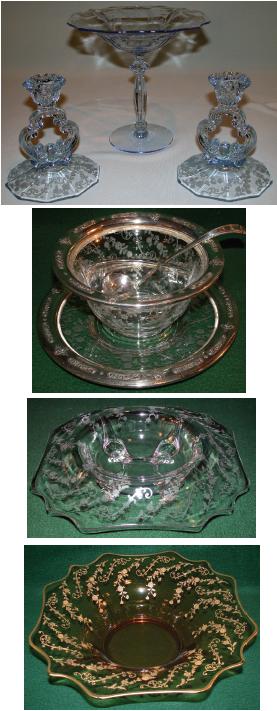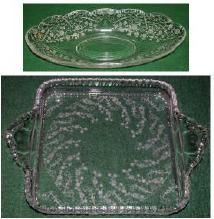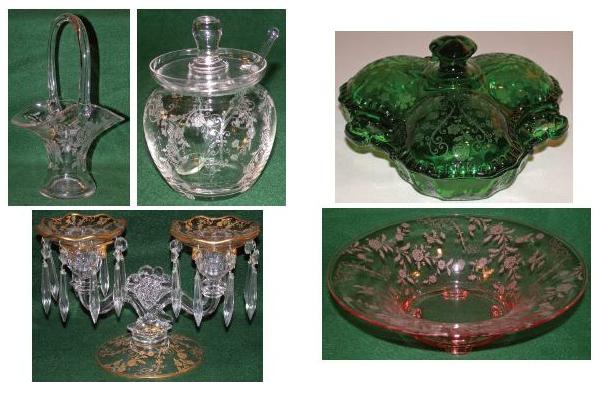What About Elaine?
by Jack & Elaine Thompson
Issue No. 430 - August 2009
In the September, 2008, Crystal Ball, Larry Everett wrote an
entertaining article titled, "Which Etching Would You Pick?"
As we read, he kept eliminating etches until he was down to
two: Portia and Elaine. When your name is Elaine, the choice
 is easy. Our collecting started rather innocently. There were
pieces of Cambridge glass around Elaine's house, but they
were just that: pieces of glass around the house. She grew up
in Cambridge and her father, Blair Stewart, worked a number
of years in the cutting department. (See October '07 Crystal
Ball). When Elaine's parents downsized into an apartment,
she received several pieces of Cambridge from them. A bit of
research on the internet ensued, and the discovery of the Elaine
pattern was made. The rest is history, as they say.
is easy. Our collecting started rather innocently. There were
pieces of Cambridge glass around Elaine's house, but they
were just that: pieces of glass around the house. She grew up
in Cambridge and her father, Blair Stewart, worked a number
of years in the cutting department. (See October '07 Crystal
Ball). When Elaine's parents downsized into an apartment,
she received several pieces of Cambridge from them. A bit of
research on the internet ensued, and the discovery of the Elaine
pattern was made. The rest is history, as they say.
We happen to think Elaine is one of the more beautiful etches, regardless of the "name thing." It's not quite as bold or busy as some of the others, and it's very elegant. That's one of the great things, though, about Cambridge glass. There is at least one etch to suit everyone's taste, because so many different and beautiful etches exist. We're not sure when our collecting philosophy originated or how it evolved. At some point we decided we wanted to collect as many different pieces of Elaine as we could. After all, we had just bought a new display case, so we had plenty of room, right? Oops!
We either chose the wrong philosophy for the etch or the wrong etch for the philosophy. Larry, did you mention something about a house addition? To be queen of the understatement, they made a lot of different Elaine pieces. We're not sure what the exact comparison is to some of the other popular etches, such as Rose Point, for example. Larry noted in his article that Elaine is found on 12 different stemware lines, the most of any etch. That topic alone could lead to another article down the road, so we will bypass that for now. The more we learn, the more we discover how many different blanks were etched Elaine.
Lynn Welker has said it's possible that just about anything in the second half of the '30-34 catalog alone could be etched Elaine. It's always exciting for us to find a piece that we didn't know existed in Elaine. Elaine's father asks his friends jokingly if they need any furniture. He is certain we must be selling some to make room for more glass.
One of the things we noticed early on about the etch itself is how many different size variations and different arrangements there are, even within the same blank. For grins, we measured the length of the scroll and found 13 different sizes. The etchings book lists 61 different prints found. For example, we have the 993 – 12" bowl in crystal with a smaller 3" scroll pattern. We also have the same bowl in pink with the larger 5" scroll pattern. This same concept is evidenced in a set of four 3500/124 – 3¼" ashtrays we purchased. Three of the four have the etching just around the perimeter. The fourth has the flower portion extending into the center. We've heard many theories on why these things occurred, including the Monday morning hangover or the normal etching guy's day off. Who's to know? We just find it interesting, and it causes us to inspect every piece that much more carefully.
Unfortunately, Cambridge
did not produce much Elaine
in color. Some of the more
"common" colors we own are
Amber and Pink. We also have
 some of what Lynn Welker calls the "wild" colors, such as
Amethyst and Forest Green. One of our favorites is Willow
Blue. Has anyone seen Elaine etched on Carmen or Royal
some of what Lynn Welker calls the "wild" colors, such as
Amethyst and Forest Green. One of our favorites is Willow
Blue. Has anyone seen Elaine etched on Carmen or Royal
 Blue? How about Crown Tuscan? A display case with all
crystal can sometimes appear bland to the eye, no matter how
it's arranged. However, when you add a piece of color Elaine,
that piece really catches the eye. One of the downsides, though,
particularly on the darker colors, is that the etch seems to
get lost in the color. We really appreciate the gold encrusted
pieces, because they show off the etch so well. And when
you combine the two, color and gold encrusting, well it just
doesn't get much better than that.
Blue? How about Crown Tuscan? A display case with all
crystal can sometimes appear bland to the eye, no matter how
it's arranged. However, when you add a piece of color Elaine,
that piece really catches the eye. One of the downsides, though,
particularly on the darker colors, is that the etch seems to
get lost in the color. We really appreciate the gold encrusted
pieces, because they show off the etch so well. And when
you combine the two, color and gold encrusting, well it just
doesn't get much better than that.
Of all the beautiful pieces belonging to Elaine, one remains a standout: the vase. The alternating vertical scroll and flowers lend themselves well to the likewise vertical nature of vases; and the taller the vase the better. Where's that 1336 - 18" palace vase with the Elaine etch on it? If you see one, let us know. The etch would really show up well on that one. While we're dreaming, how about making it Carmen, gold encrusted … Wow!
Another treatment we like on Elaine pieces, although uncommon, is with sterling silver rims. All the pieces we have run across were completed by the Weidlich Sterling Spoon Company of Bridgeport, Connecticut. They were in business about the same time as Cambridge, from 1915 to 1952. The few pieces we have seen so far are all from Cambridge's Round Line. Other treatments we find interesting include platinum trim (very difficult to photograph) and the different brass filigree holders.
There are some common questions we receive from collectors
and non-collectors alike. "What was your first Elaine piece?"
 and "What is your favorite Elaine piece?" The answer
to the first question is easy, the 3500/61 - 6½", 1 handle,
3 compartment relish. The second question is extremely
difficult, if not impossible. Yet there are some that stand
out for us: the #119 basket; the Pristine #225 – 9½" 2-part
bowl, blown; the 1402/94 – 12" celery; the 3500/57 – 8" 3
compartment candy box & cover in Forest Green; and the
3400/14 – 7" tall comport in Willow Blue.
and "What is your favorite Elaine piece?" The answer
to the first question is easy, the 3500/61 - 6½", 1 handle,
3 compartment relish. The second question is extremely
difficult, if not impossible. Yet there are some that stand
out for us: the #119 basket; the Pristine #225 – 9½" 2-part
bowl, blown; the 1402/94 – 12" celery; the 3500/57 – 8" 3
compartment candy box & cover in Forest Green; and the
3400/14 – 7" tall comport in Willow Blue.
Collecting Elaine has become a passion, but we do hold to a philosophy: we want to display everything we own. We love looking at our glass, and we miss pieces that are temporarily packed away. We also love showing it to people. And as you all know, there is a difference between showing the glass to Cambridge collectors and to non-glass collectors. Non glass collectors will meander past the cases and look and comment how pretty it is. Even though they are sincere and do enjoy it, it's not quite the same as engaging in conversation with a fellow Cambridge collector. There is meaning in the words, "You don't see that piece very often" or "I didn't know they made that in Elaine" or "I have that piece in Wildflower or Rose Point." When showing our collection to a non-glass collector, we will point out how Cambridge took a piece out of the mold and made three, four, or sometimes six different shapes from it. Take the 3500/25, 26 and 27 ram's head bowls for example. It is not hard for someone to imagine how a worker would take a tool and turn the 25 blank into the 26 or 27. Suddenly, the glass comes to life for them.
We have occasionally wondered if there hadn't been an Elaine pattern would we have gotten into Cambridge glass at all. Would we have captured the Cambridge "bug", with which we are so seriously afflicted? Who's to know? Having the same name as the pattern you collect does have its benefits. People tend to think of you when they see Elaine pieces, and that has meant a great deal to us. Many times people have taken the time and trouble to call us to inquire if we have a particular piece they have come across. We've met so many wonderful people and developed so many friendships in NCC. Life is enriched by the relationships we have because of the passion we all share. We're glad things turned out the way they did.


